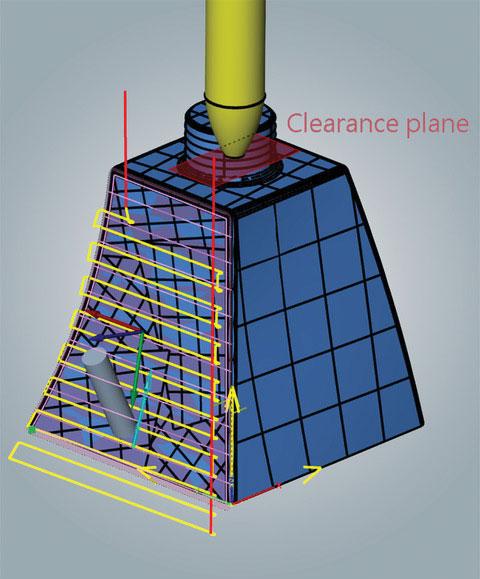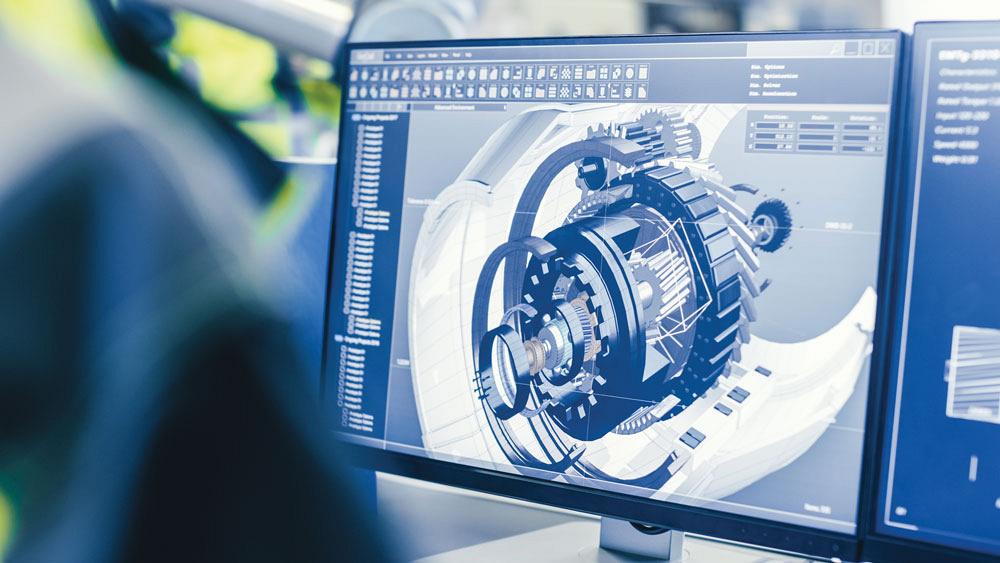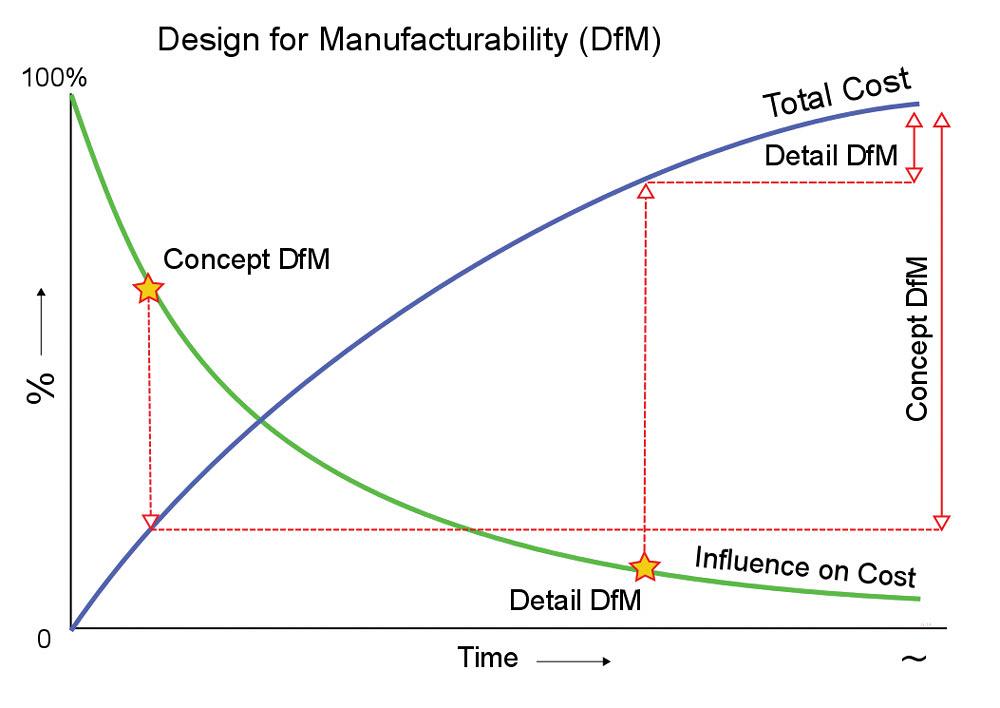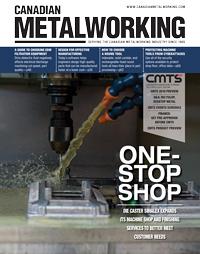Associate Editor
- FMA
- The Fabricator
- FABTECH
- Canadian Metalworking
Design for effective manufacturing
Software helps engineers design high-quality parts that can be manufactured faster at a lower cost
- By Lindsay Luminoso
- October 2, 2019
- Article
- Automation and Software
It can be challenging to get design engineers and operators on the shop floor in the same room on a regular basis to discuss design and manufacturing. It takes time and money that shops just don’t have. Design engineers by training generally have little to no manufacturing experience, which makes it hard for them to understand how to design products that are easily and inexpensively manufactured.
"Historically, design and manufacturing disciplines are not closely linked," said Alan Levine, managing director, Open Mind Technologies USA, Needham, Mass. "Manufacturers often receive a ‘print’ that is approved for manufacture."
According to Levine, in many organizations, design and manufacturing departments and reporting chains are independent up to the vice-president level. And in many cases, they are also housed in different buildings, possibly in different cities. With this challenge, many companies have taken steps to include more rigorous project review and other multidiscipline teams who are tasked to consider manufacturing (and cost) impact before the design is locked.
Another area of improvement is in today’s design software, which is helping to bridge the gap between these two groups by offering a number of features that optimize design for manufacturing (DFM). Software that focuses on DFM allows engineers to select the right processes and materials with optimized parameters and tolerances to ensure the successful manufacturing of a product. It helps save costly design rework for meeting realistic goals under the budget.
INTELLIGENT SOFTWARE
Industry 4.0 is a significant trend that is affecting both the manufacturing and product design industry. As more and more shops are looking to integrate Industry 4.0 onto the shop floor, so too are developers into the software. Cloud-based applications are becoming increasingly popular and more intelligent.
"Access to cloud computing and artificial intelligence is huge right now," said Lars Christensen, technical marketing manager, Autodesk, San Rafael, Calif. "Today’s designers can actually use AI-based algorithms to define their end goals before they start the design process. They can outline customer specifications and manufacturing capabilities, and the computer will generate multiple options that are verified toward the end goals that are set, almost utilizing the software as an upfront exploration tool for design and engineering solutions."
This is helpful, especially for new designers who don’t have the experience or familiarity with manufacturing processes to rely on instinct alone. All manufacturer-specific data and rules are stored in the cloud for the software to harness and apply to design iterations. For instance, today’s software companies work closely with machine tool OEMs to help build up these libraries of process information and a set of industry-standard rules to meet DFM needs.
"Experienced users can also input sets of rules and guidelines into the software that other users can follow," said Aaron Guo, owner, Longterm Technology Services, London, Ont., Siemens PLM software distribution and technology partner in Canada. "Users can run a check against the rules, a verification of sorts, which will determine if the product is good to manufacture or not based on the outlined rules."
Whether it’s a hole for which the length-to-diameter ratio is too deep or the inclusion of lots of small-diameter holes, designers are not always aware of how much additional cost each feature adds. Fillets and chamfers are extremely easy to integrate in design software, but again, they add significant overall costs to a part and are not always necessary for functionality. Having some industry wide best practices will help designers make informed decisions on manufacturability as well.
In the last decade, many software companies looked to integrate CAM software features directly into 3D modelling software. This integration is specifically helpful in situations of multiple design iterations or large product families, where a designer can go into the software and make adjustments that will then be automatically updated on the CAM side.
"There are always a few changes being made at the last minute," said Christensen. "Many years ago this would happen on the drafting board, but today, when a designer makes a change, no matter how big or small, that change would be applied and automatically updated on the toolpath that a CNC programmer developed. So now we can take that 3D design and apply all the toolpaths and post out the code that the machine needs in the language it needs to start machining all in one environment."
Tools within the software allow users to highlight an area like a chamfer or a group of features to see if adjustments can be made. These operations can be done in one work flow, making it a tool for collaboration between designers and manufacturers to produce better products.
VERIFICATION AND SIMULATION
Traditional design verification process is an expensive and time-consuming process that can effectively be tamed with the use of technology.
"Applying simulation at a very early stage of product design is becoming popular," said Guo. "As previously mentioned, lots of knowledge has been captured and embedded into the software. The requirements for designers to have all the knowledge of the whole manufacturing processes have even dramatically reduced. They can easily simulate the processes before finalizing the design."
This makes designing good-quality parts much simpler and faster. It’s much harder to go back to the drawing board after the part is completed and sent to manufacturing, and a waste of time. Checking earlier in the process gives designers and operators confidence that the job can be done effectively.
"Designers are able to focus on the design and can use the software to help simulate and evaluate the manufacturing process," said Guo. "For example, the simulation will help determine whether a part can be manufactured; designers can verify and edit in the design stage and determine whether the material is strong enough. They can even use the CAE software to verify whether material or features can be optimized to last longer. Or how the part can be adapted to reduce cost and weight of the material."
BEST PRACTICES
According to the experts, not placing enough importance on manufacturability is a major challenge in the industry.
"Depending on the product or project, DFM can take on different forms," said Levine. "Some of the key topics that can be reviewed and make a large impact are part or feature tolerances and items like minimum fillet radius."
Levine explained that designers often do not have a deep understanding of manufacturing processes and may define various tolerances that are too tight. These part features may then require special machining processes that increase cost, while a looser tolerance may be sufficient in many cases. Similarly, defining an artificially small fillet radius can increase manufacturing cost by requiring a smaller cutter and the associated manufacturing challenges, such as deflection and cutter aspect ratio.
"Keeping things traditional has always been a trusted practice to keep the processes tamed," said Chetan Gautam, technical support engineer, Longterm Technology Services. "Not adding square holes wherever they are not required is also among the best-known practices. Giving precedence to functional requirements is another area where common wisdom applies."

In hyperMILL ® 2019.2, the hyperCAD ®-S "Global fitting" function is directly integrated into the CAM strategy for 5-axis tangent machining. With this function, multiple faces can be joined into one face with a controlled ISO orientation. These dedicated CAD utilities streamline CAM programming and provide tested and proven methodologies. Photo courtesy of Open Mind Technologies.
Guo added that finding the right people, equipment, and configuration of processes is the key to make right product and make the product right. Software plays an important role, which means that software with capabilities for all CAD/CAM/CAE functions can shorten the learning curve and implement new technologies quickly.
DIGITAL TWIN
Creating a digital twin was generally something done by large enterprises, however; with the rise of Industry 4.0, more and more companies of all sizes are opting for this productivity-enhancing option. A digital twin is a virtual replica that includes all characteristics and features that can be verified by software. Using this as an option reduces lengthy physical tests needed to verify prototypes.
"With a digital twin, we duplicate everything in the virtual world," said Guo. "We can then design in the virtual world, manufacture in the virtual world, and even simulate all of these aspects in the virtual world to confirm everything works before we apply for production."
Guo pointed out that a digital twin is especially useful for creating new product designs and cuts down on time, reduces costs, and improves quality. He explained that many manufacturers were initially put off by the high cost, but in recent years it has become more affordable.
"Virtual validation using simulations has proven to be a boon for the manufacturing industry," said Guo. "One person does not have to go through the entire process of manufacturing the product and then find out whether the design will meet all the requirements. You can let the software do all the calculations with the initial parameters. You may not have to rely fully on his wisdom to visually inspect for field performance. This can all be done with the use of trusted software applications. It is all done without cutting a single ounce of steel."
FUTURE TRENDS
Current software is leveraging the latest technology to make design and manufacturing more complementary processes. For decades these two essential areas have been very segmented, but with new DFM tools, everyone has a hand in minimizing costs and time while maximizing quality.
"The next wave we are seeing is in generative design, where before even starting a product design, a manufacturer can send information about what is possible on its shop floor," said Christensen. "This process will actually have information going from the machines and back into the software. When a designer sends a job to the shop floor, the software can process a CNC program and use science to determine proper tools with speeds and feeds."
The beauty of something like this is that the next time a similar job is done, the software will know the exact machining parameters and adjust them based on design and CNC program changes.
"Also, once designs are set, there are growing trends to pass the CAD model together with PMI to the CAM system," said Levine. "The manufacturing engineer can then see the datum and GDT information directly in the CAM system, rather than referring to blueprints that are supplied in addition to the CAD model. This is an important process improvement but focuses more on reducing human error to read and compare models and blueprints than actually defining more effective part designs."
Levine added that taking advantage of DFM and defining a database of proven best practices can help reduce uncertainty and risk in project plans. Poorly defined parts can have increased cost or development times that can make or break a shop’s bottom line. Today’s software is becoming smarter, less expensive, highly intuitive, and more accessible. Both designers and manufacturers will benefit from the integration of DFM methods and best practices.
Associate Editor Lindsay Luminoso can be reached at lluminoso@canadianmetalworking.com.Autodesk, www.autodesk.comLongterm Technology Services, www.longtermtec.comOpen Mind Technologies, www.openmind-tech.comAbout the Author

Lindsay Luminoso
1154 Warden Avenue
Toronto, M1R 0A1 Canada
Lindsay Luminoso, associate editor, contributes to both Canadian Metalworking and Canadian Fabricating & Welding. She worked as an associate editor/web editor, at Canadian Metalworking from 2014-2016 and was most recently an associate editor at Design Engineering.
Luminoso has a bachelor of arts from Carleton University, a bachelor of education from Ottawa University, and a graduate certificate in book, magazine, and digital publishing from Centennial College.
subscribe now


Keep up to date with the latest news, events, and technology for all things metal from our pair of monthly magazines written specifically for Canadian manufacturers!
Start Your Free Subscription- Industry Events
MME Winnipeg
- April 30, 2024
- Winnipeg, ON Canada
CTMA Economic Uncertainty: Helping You Navigate Windsor Seminar
- April 30, 2024
- Windsor, ON Canada
CTMA Economic Uncertainty: Helping You Navigate Kitchener Seminar
- May 2, 2024
- Kitchener, ON Canada
Automate 2024
- May 6 - 9, 2024
- Chicago, IL
ANCA Open House
- May 7 - 8, 2024
- Wixom, MI






















